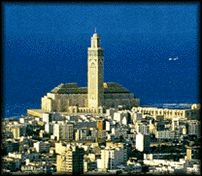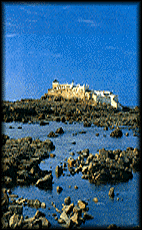
 |
Middle East International Services | Commerce | Almusaafer | Higher Education |
| Language Services | Arabic Course | Resource Center | ||
 Casablanca Attractions
Casablanca Attractions
Press to go back to:
[Casablanca Sightseeing Index]
[Morocco Sightseeing Index]
[Moroccan Index]
To leave Morocco press:
[Country Search]
[Home Page]

NOT TO BE MISSED:
The Central Market
The Casablanca Central Market is truly a feast for the senses. There are so many delectable products superbly presented that, if you are staying in a hotel, you will almost wish you had cooking facilities of your own! Fish and seafood straight out of the ocean, pyramids of fruit and vegetables mixed together with flowers bursting with color.
A Visit To The Marabout
A few kilometers from "Casa", on a rocky island that can only be reached at low tide, stands the Marabout de Sidi Abderrahmane koubba, magnificent in the light of the setting sun. The holy man was said to have had miraculous powers - and judging by the sick and infirm who come to visit his tomb hoping for a cure, there must be many who believe that it is true.

The Magic Of Place Mohamed V
There is so much to admire in Place Mohamed V by day. What magnificent architecture! The Post Office, the Palace of Justice, the Prefecture, the French Consulate and the Bank of Morocco all set around the central fountain... which, by night, comes alive with lights in a gloriously enchanting spectacle.The prayer hall can accommodate 25,000 of the faithful, and the esplanade 80,000 more. The traditional Moroccan architecture here reaches its zenith with the use of ultra-sophisticated technology.3,300 craftsmen from all over the kingdom worked together to build this monument on pile foundations covering 2 hectares,
erect the world's tallest minaret (200 meters), install the retractable roof which, in three minutes, can transform the prayer hall into a magnificent patio, sculpt 10,000 square meters of decorations, 67,000 square meters of plaster, 53,000 square meters of wood... The Great Hassan II Mosque is quite simply dazzling. In Casablanca, even the souks have benefited from the march of progress. And how magnificently! Built at the beginning of the century, the Habbous district seems as if it has been throbbing with activity since the dawn of time. Punctuated by attractive little shaded squares, narrow streets lined with arcades lead from one souk to another. Here, the coppersmiths shape teapots, cauldrons, chandeliers, vases, lanterns and trays... These are the bazaars bursting with all kinds of merchandise in all imaginable colors... on one side there is the curious and fragrant olive souk... on the other the pastry shops piled high with appetizing doughnuts, "cornes de gazelles" and date cakes... Rows of mechanical sewing machines being worked by men in djellabas... strange but wonderful antique shops selling fascinating and beautiful objets d'art...
In this quarter stands the Mahkama du Pacha, the sumptuous edifice which houses both the court of justice and reception rooms for state occasions. And, a little further on, the Notre Dame de Lourdes church, a monumental concrete sculpture dating from the 50's, lit by vast stained glass windows covering an area of 800 square meters.
In comparison, the old medina appears like an extravagant labyrinth which has fortunately been contained within the ramparts. What a delight it is to wander through its bustling streets - watching the never-ending spectacle of barbers, butchers, grocers, ironmongers and their throngs of customers...
But if, during the day, Casablanca is alive with dynamism, during the evening you can drink in the sea air on the famous corniche, the area preferred by those looking for the night life, with its beaches and swimming pools, its fashionable bars, restaurants and hotels.
Around And About In The Casablanca Region
The inhabitants of Casablanca only have to travel a few kilometers to enjoy a wide variety of activities. Don't be afraid to follow suit : relax by the sea, go for walks in the beautiful forests or steep yourself in history as you visit the ancient fortified cities...
28 km to the north stretch sandy beaches, with a casino, luxury hotels, a racecourse, a yacht-club and an 18 hole golf course beside the sea. This is Mohammedia, the Casablancans' favorite resort which also boasts one of the country's most active ports - possessing a history going back to the XIVth century when it was visited by ships from Pisa, Genoa, Venice and Portugal.
A little further to the east, Ben Slimane is the place to go if you are interested in more rural pursuits. Hiking or hunting in the magnificent Ziaidas cork-oak forest or perhaps a round of golf on the endearing nine hole course with its lake populated by splendid carp and flocks of wild duck.
In the plain, to the south, stretch the renowned Boulaouane vineyards which produce the celebrated rose wine. Don't be surprised if you catch sight of a falcon flying overhead, for Boulaouane is not only internationally famous for its wine; it is also one of the greatest centers of falconry. The falcon itself is situated in a spectacular kasbah built in 1710 by Moulay Ismail consisting of a rectangular walled area with 7 bastions.
On the coast, 100 kilometers to the south, discover the old fortified cities, former Portuguese trading posts.
Azemmour is surrounded by ochre ramparts, from which projects a small platform overlooking the reddish waters of the Oum er-Rbia estuary, famous for its delicious alosa, the local culinary specialty. The medina is superb with its white, square houses, livened up by bougainvillea, rising on terraces among the olive and pomegranate trees.
Considered as offering the best shelter on the entire Atlantic coast, El Jadida was the scene of bitter fighting with the Portuguese, who finally lost it in 1769. A walk around the ramparts gives splendid views over the surrounding country, while from each of the five bastions you can see over the port, the moat and the clustered houses... You must not miss the huge 1100 square meter underground reservoir in which the water and the light combine to throw the amazing gothic architecture into sharp relief; a setting often used by film-makers, in particular Orson Welles for his "Othello".